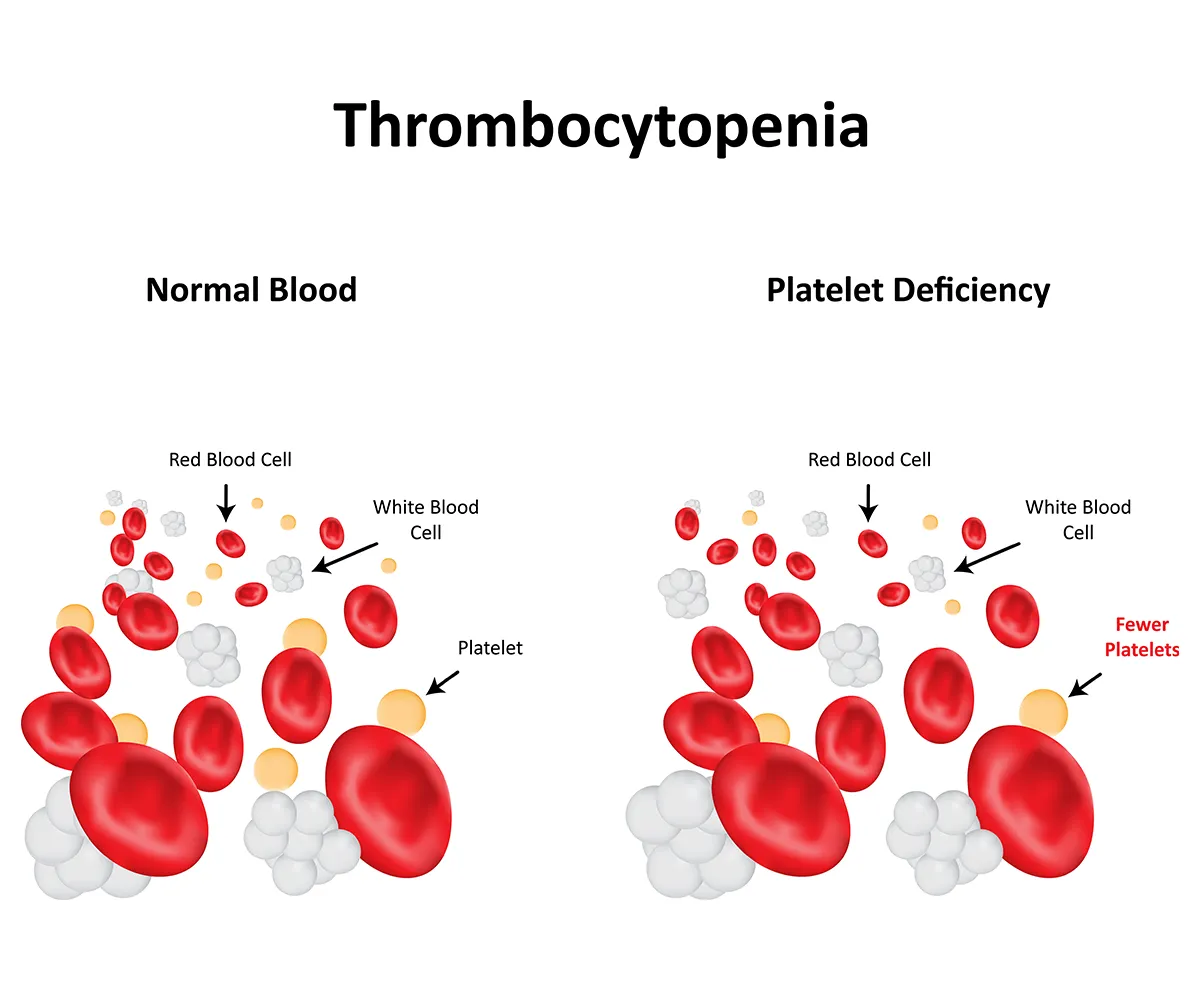Platelet disorders
Platelet disorders can impact your child’s health in significant ways, affecting the blood’s ability to clot and leading to potential problems such as excessive or abnormal bleeding and slow wound healing.
Whether your child’s platelet count is below the lower limit of normal or they have an elevated level of platelets, we’re here to help. At Advocate Children’s Hospital’s Fetal Care Center, our team of experts have experience treating children with platelet disorders, including thrombocytopenia (low platelets) and thrombocytosis (high platelet count).

When your baby has thrombocytopenia, they have lower-than-normal levels of platelets in their blood.
What are platelet disorders?
Platelets are tiny cells in the blood that play a crucial role in clotting, which helps your child’s body stop bleeding if they are cut or injured. When you or your child get a cut, platelets rush to the site to form a clot and stop the bleeding.
A normal platelet count range is typically 150,000 to 450,000 platelets per microliter of blood. Values below this range indicate thrombocytopenia (low platelet count), while values above it indicate thrombocytosis (high platelet count).
Types of platelet disorders
Platelet disorders fall into several categories:
- Thrombocytopenia: This condition occurs when platelet count is low. Causes can include infections, autoimmune diseases, bone marrow issues or certain medications.
- Thrombocytosis: This condition, also known as a high platelet count, occurs when there are more platelets than the normal range. It can be caused by underlying conditions such as inflammation, iron deficiency or certain bone marrow disorders.
- Platelet membrane abnormalities: Inherited disorders where the platelets’ structure affects their ability to function correctly.
- Platelet dysfunction: This condition occurs when platelets are present in a normal range but don’t work as they should, leading to clotting problems.
Inherited platelet disorders, where platelet function is affected, are another type of platelet disorder.
What are the symptoms of a platelet disorder?
Platelet disorders can present with various symptoms depending on whether the platelet count is high or low. In many cases of thrombocytosis, your child may not have any symptoms. Here are the signs of both high and low platelets.
Symptoms of low platelets (thrombocytopenia):
- Easy or excessive bruising
- Prolonged bleeding from cuts or scrapes
- Unexplained nosebleeds
- Abnormal bleeding from the gums
- Small red or purple spots on the skin (petechiae)
- Heavy menstrual periods in teens
Symptoms of high platelets (thrombocytosis):
- Headaches or dizziness
- Weakness or fatigue
What causes platelet disorders?
The causes of platelet disorders vary based on the type. Some common factors for low platelets include:
- Viral infections such as Epstein-Barr or hepatitis.
- Autoimmune diseases like lupus.
- Bone marrow disorders, including leukemia.
- Certain medications, including chemotherapy drugs.
- Nutritional deficiencies, such as low vitamin B12 or folate.
Causes of high platelet count are slightly different and include chronic inflammatory conditions like arthritis, iron deficiency anemia or certain bone marrow conditions.
Platelet disorders and pregnancy
Platelet disorders during pregnancy can impact maternal and fetal health, requiring careful monitoring and management. These disorders typically involve either a reduction in platelet count (thrombocytopenia) or dysfunction of the platelets, which can lead to complications such as excessive bleeding or issues during delivery.
Postnatal care for the newborn with platelet disorders may include platelet transfusions if your child has severely low platelet counts.
If your obstetrician finds you have a platelet disorder, they will work with a multidisciplinary care team during pre- and postnatal care which may include hematologists and neonatologists to minimize the risks for both you and your baby.
How are platelet disorders diagnosed?
Diagnosing a platelet disorder often begins with your child’s doctor ordering a complete blood count (CBC) test, which measures the number of platelets in your child’s blood. If the results show a platelet count outside the normal range, additional tests may be recommended to determine the cause. These can include:
- Blood smear to examine platelets under a microscope
- Bone marrow biopsy in cases where bone marrow disorders are suspected
- Genetic testing for inherited platelet disorders
Your doctor may also ask about your child’s medical history and perform a physical exam to look for signs of abnormal bleeding or bruising.
Treatment for platelet disorders
Platelet disorder treatment depends on the underlying cause and severity of the condition. For low platelet count, treatment could include treating the underlying cause, platelet transfusions or medications, such as corticosteroids.
For high platelet counts, treatments will consist of treating any underlying conditions causing the elevated platelets and medications to reduce platelet production or prevent blood clots.
Tailored treatments, including medications or lifestyle adjustments to reduce bleeding risk may be used to treat inherited platelet disorders or platelet dysfunction.
Get Care
Kid-focused. Close to home. We’re here for your child in person and online.





